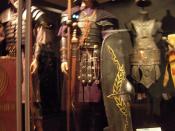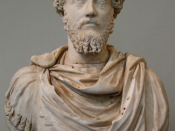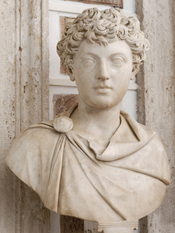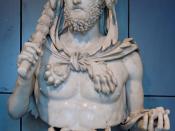An Archetypal Point of View An archetype can be found in a book, short story, or a movie, but it must contain specific elements. Most archetypal works contain a general "fight, flight, learn, return"ÃÂ pattern apparent physically or emotionally. Symbolic people, places, and objects can be found in an archetypal works also. Gladiator fulfills all of these requirements; therefore, it is an excellent example of an archetypal movie.
Maximus Dessimus Meridius is the main character and the hero in the film Gladiator directed by Ridley Scott. He is given instructions by Emperor Marcus Aurelius to return Rome to the people because of the corruption by the leaders. While thinking about the Emperor's decision Maximus is awakened to discover the emperor has been "slain"ÃÂ by his son Commodus; therefore, nobody knew of the Emperor's wishes for Maximus to succeed him instead of Commodus. This sets off Maximus' quest for vengeance.
His journey does stay true to the "fight, flight, learn, return"ÃÂ pattern. After the death of the true Emperor, Commodus orders Maximus be killed. He is taken into the wilderness by four guards, but he fights for his freedom and manages to escape with only one wound on his arm. Then he advanced to his home to find his wife and son dead. After burying them he is taken and sold to Proximo, a man who makes men fight as gladiators. Here he learns how he is to avenge the Emperor's death and give Rome back to the people. Then he returns to Rome as a gladiator and kills Commodus in a battle with all of the people of Rome watching at the Coliseum.
Specific characteristics are needed for a character to be considered as an archetypal person. Emperor Marcus Aurelius would be the herald in this film because he announces the challenge that begins Maximus' journey. Commodus was Maximus' opponent throughout the movie; therefore, making him a shadow. When Maximus' is first beginning to be a gladiator, Proximo, the threshold guardian, proves that the journey will be difficult. Proximo tells him that he must "win the crowd"ÃÂ to win his freedom. Lucilla, Commodus' sister, is the ruined maiden because her husband is dead, and she is in love with Maximus. Juba was the faithful companion to Maximus. He helped him get through his gladiator days and kept his spirits up. A juba is a lively South African dance; therefore, conveying the meaning of Juba's role in the film.
Many archetypal symbols are present in Gladiator. The snow is present throughout the very first battle in Germania with the Barbarians. This symbolized the rigidity and death all through the war. The fire throughout the film symbolized creativity and passion. When Maximus returned home to find his wife and son there was fire showing his passion to avenge his family's death. When Commodus is talking to Lucilla about dissolving the senate he is surrounded by torches and fire lit objects. In the scene recurring where Maximus is travelling through a field towards his final home the wind is blowing. This symbolizes spirit and inspiration for Maximus to be reunited with his family.
Some archetypal places present in the film are the city, the rock, and the threshold. The city is described as the place of corruption and hypocrisy. The emperors were corrupting Rome and only had their minds set on one thing; they were not paying attention to what Rome needed. The rock is the stony place of suffering, and in this case it is Maximus' home when he finds his family. The threshold is the gateway into a new world for the hero. The first gladiator match would be the threshold because he needed to become a gladiator to avenge Emperor Marcus Aurelius and kill Commodus.
Gladiator is an exemplary archetypal film containing the "fight, flight, learn, return"ÃÂ motif, the symbolic people, places, and objects needed to fulfill the requirements of an archetype.





